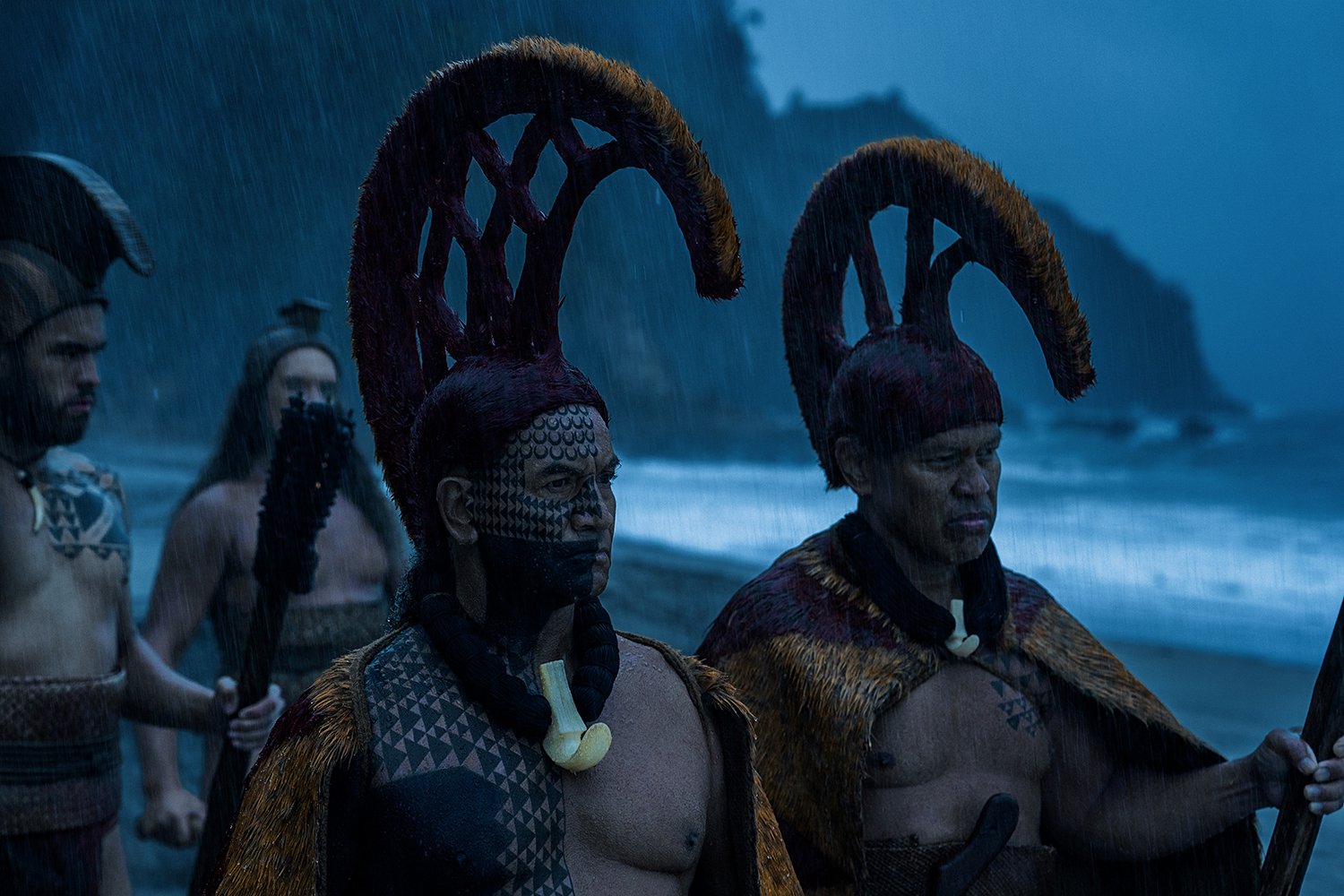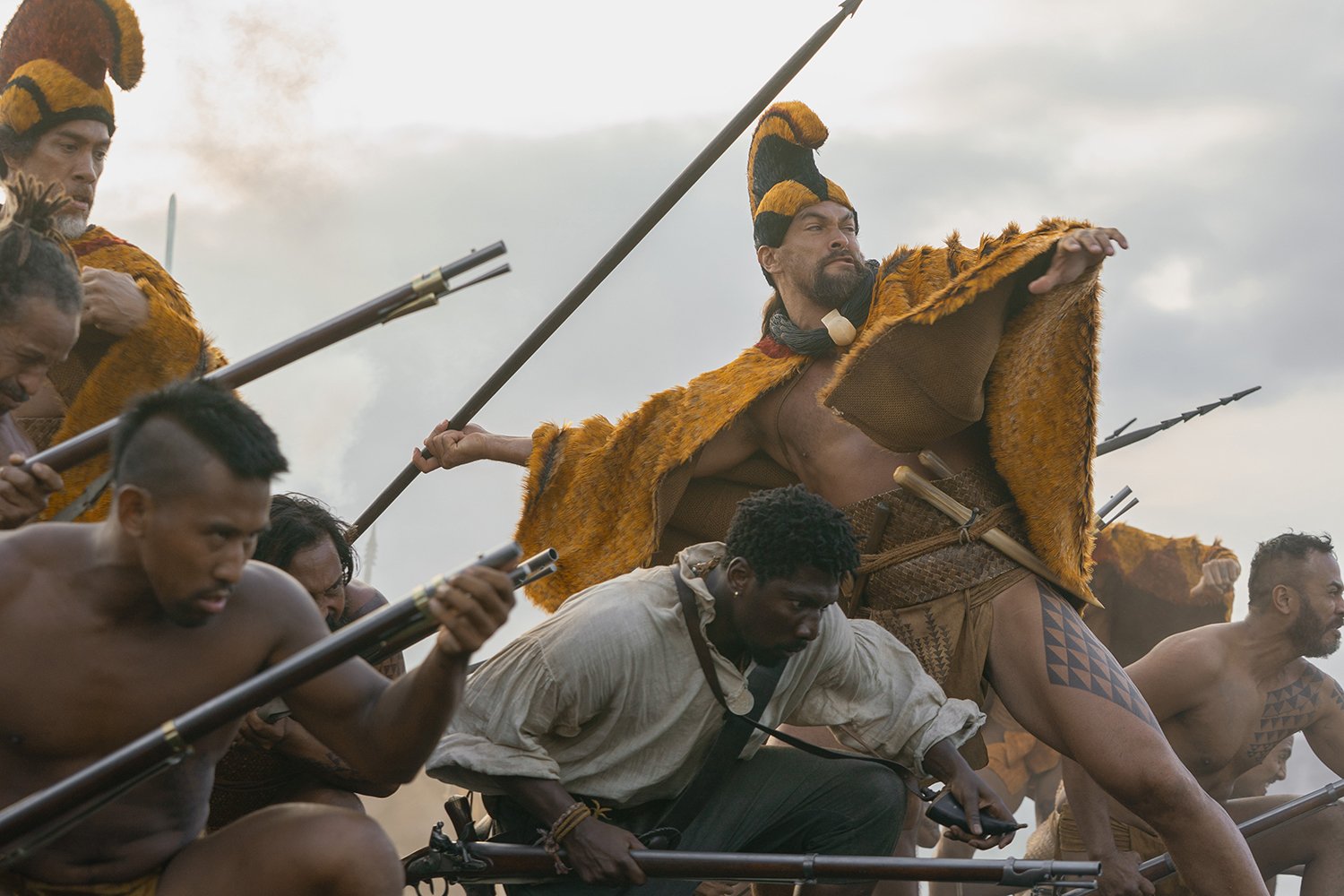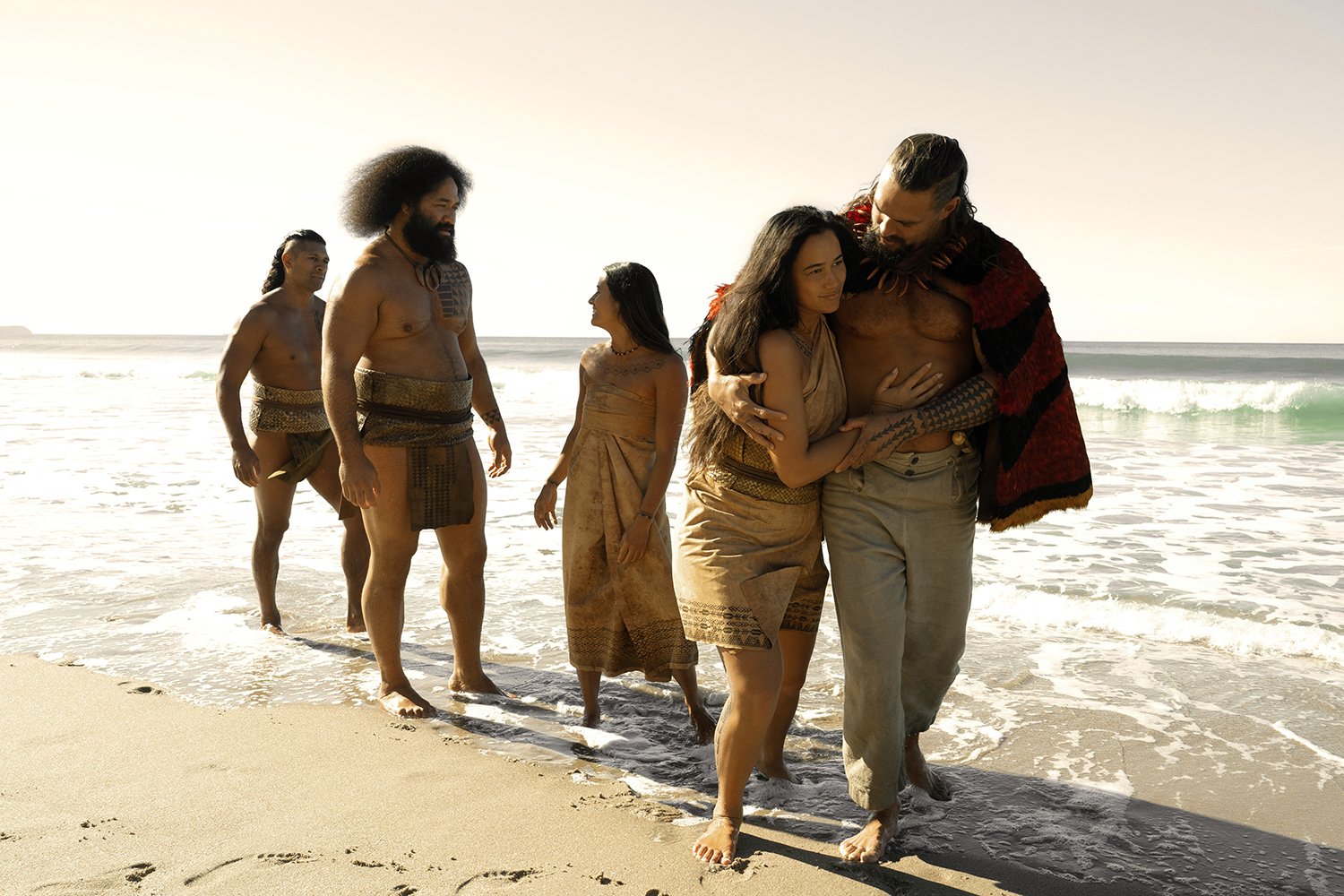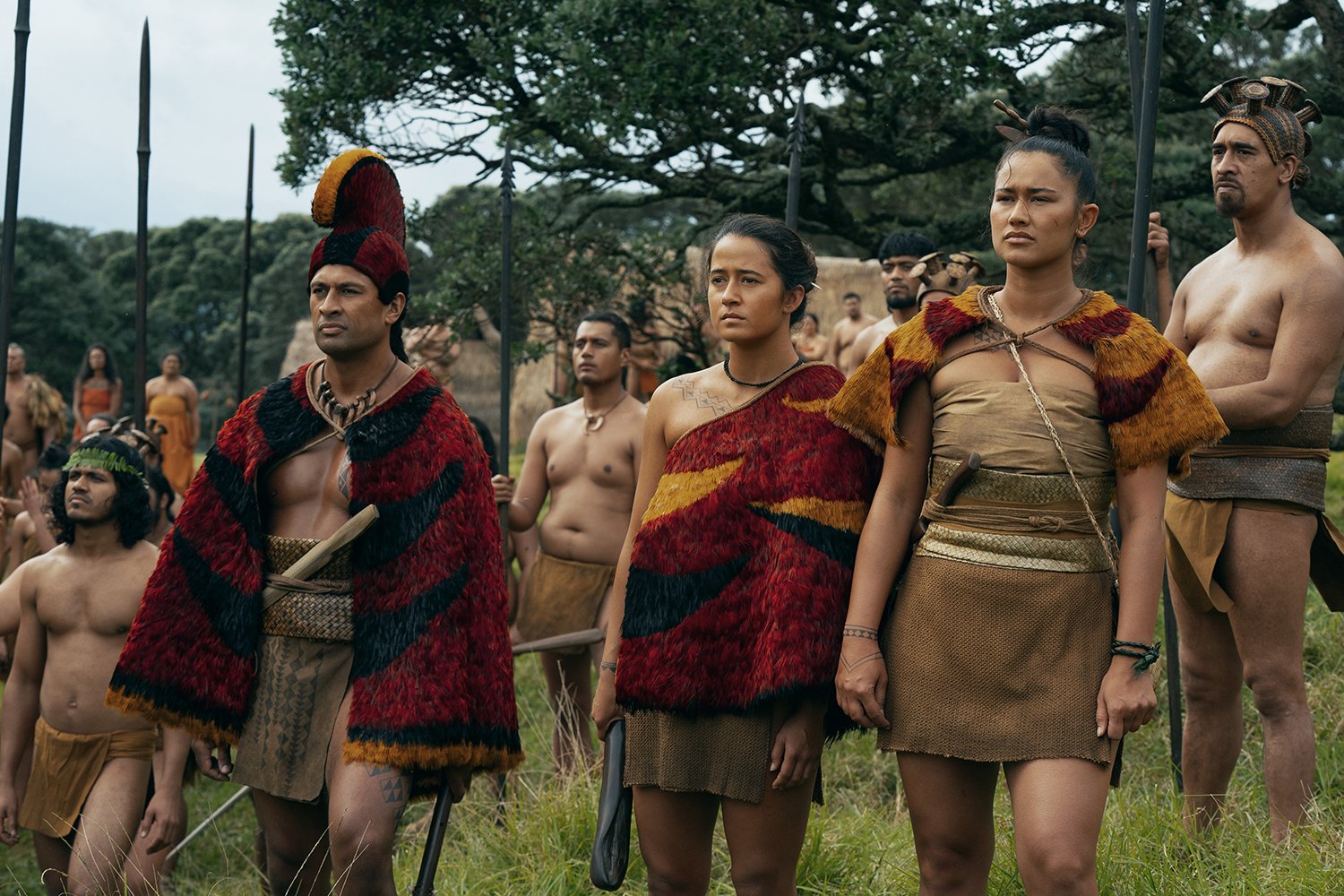“We’re a part of America but no one really knows our story.” This throwaway line that actor (and, in this case, producer, co-writer, and—for the season finale—director) Jason Momoa said while promoting his new TV show about Hawaiian unification, Chief of War, on the SmartLess podcast, rang out with a surprising resonance.
He was talking to three fellow celebs—podcast cohosts Will Arnett, Jason Bateman, and Sean Hayes—and the vibe on their show (one of the better ones, if you were looking for yet another podcast to listen to) is “this is how people in Hollywood actually talk to one another.” So in a way, it is to be commended that the hosts felt chummy enough with Momoa to show their complete cluelessness about Hawaii, where surely all of them have been on vacation.
“Who was Cook?” one interrupted (I won’t name-and-shame) when Momoa referenced the first Westerner to reach the Hawaiian islands. Another wondered if the settlement of Hawaii by whites went smoothly. The musclebound Momoa, who was born in Hawaii to a Hawaiian father, and whose great-uncle is a nonagenarian surfer of great repute named Buffalo Keaulana, didn’t flip over any desks; he just continued to talk up his new show, which would, if they watched it, answer all their questions.

Chief of War is set not long after Captain James Cook’s death, in the late 1700s, and follows the inter-island wars between Maui’s King Kahekili and Hawai’i’s King Kamehameha (among other belligerents). “We’ve only had [these images] in paintings and museums,” Momoa told the SmartLess hosts, reiterating how strange it is that this part of history in what is now the United States is so unknown to Americans. He noted that there have been movies from Aotearoa (the Maori name for New Zealand) like Once Were Warriors and Whale Rider, but nothing like this. He boasted about the show’s accurate costumes, props, and sets, and referred to the project as “my Braveheart, or my Dances With Wolves.”
Citing two Oscar winners is a great way to make a TV show seem important, but Chief of War does have a lot in common with many acclaimed action projects, including ones in which Momoa has starred. The rich lore of both Dune and Game of Thrones (and let’s not forget his turn in the fun-but-less-acclaimed Conan the Barbarian reboot) are mirrored here, with many conflicted allegiances, a vast array of characters, and a mythos of signs and prophecies interpreted by seers whispering in the ears of generals. And with the Hawaiian islands being islands, it’s difficult not to think about Momoa’s notable performance as DC Comics’ Aquaman—especially when the very first scene of the very first episode shows him wrangling then riding a shark.
Momoa claims that there are accounts of Hawaiians actually doing this, and who in their right mind is going to disagree, especially considering how cool he looks. There are several great acts of derring-do in Chief of War, and cursory internet research shows that many of the show’s far-fetched moments have accurate roots. When chest-puffing contestants agreed to settle a score by sledding down a cliffside at preposterous speeds, I thought, “Oh, this has to be fake,” but soon discovered that, while there surely was some exaggeration in the show, Houla sledding off the side of a volcano actually happened.
Chief of War may be action packed and extremely violent (the final episode looks the bloodshed in Game of Thrones dead in the face then rips out its tongue) but the show, which is primarily in the Hawaiian language, remains steeped in actual Hawaiian history and culture. Those shark-tooth clubs, obsidian blades, and enormous spears are gruesome as hell, but all check out.

Momoa plays Ka‘iana, who—in the tradition of so many great prestige television series heroes—just wants to be left in peace (in this case, in self-exile on the island of Kauai), but whom circumstances thrust into great and bloody tumult. This follows the arc of the central figures in Deadwood and Sons of Anarchy and even The Sopranos to a degree, and certainly that of Ned Stark in Game of Thrones, the series where most audiences first encountered Momoa as the power-seeking Khal Drogo.
Ka‘iana, who did exist, is a former Mauian chief of war, enjoying retirement with his wife, two brothers, and sister-in-law. Trouble comes when he is called back to Maui, because the king, Kahekili, reports that neighboring island Oahu is making moves, and he feels there should be a preemptive strike.
This turns out to be a lie, and Ka‘iana finds himself unwittingly aiding a massacre. Kahekili wants to rule all the islands, which (if I may summarize in very broad strokes) may become a more attainable goal once king of the island of Hawai’i, Kalaniopu’u, dies and splits his power between his son Keoua and his brighter, fairer, and more capable nephew Kamehameha. Keoua isn’t too keen on the power-sharing idea, which will lead to a big rock ‘em sock ‘em showdown.
On Kamehameha’s side is his levelheaded and righteous wife, Ka‘ahumanu, and, in time, our hero Ka‘iana who, by the time of the big finish, has returned from an around-the-world adventure. How he ended up traveling to distant realms is too complicated to get into here, but know that he made it all the way to Alaska (there are some shots of him flabbergasted by snow, have no fear) and to the Philippine port of Zamboanga, where he first witnesses the cruelty of the white man as well as the harsh realities of capitalism.

I’m leaving out the love triangles and the return of characters you thought were dead that make Chief of War a juicy soap opera—and I won’t get into too much detail about the mighty Momoa in a character-appropriate lack of clothing. (“Foreign men are obsessed with covering their genitals,” Ka‘iana chuckles at one point.) All the interpersonal drama is loads of fun, but I liked best was learning about Hawaiian customs like Kanawai Mamalahoe, in which the strong are obligated to protect the weak, even visitors who may not be trustworthy.
Another cool one is the consumption of “nightmare fish,” a hallucinogenic sea creature that acts similar to peyote and gives the raving King Kahekili even more violent visions. (Some poking around suggests that he was eating yellowstripe goatfish, also known as Weke ’a’a, which, under certain circumstances, could cause ichthyoallyeinotoxism, a sensation similar to ingesting LSD.) Then there’s the moment when someone must not just “bend the knee” to a new master, but “offer his teeth”—a brutal, novocaine-free process that’s pretty difficult to watch.
I had trouble determining just how much of that was true, though tooth ablation in general was a Hawaiian custom, as was a general awe and respect for the bones of a foe—or a loved one. There is a lot of talk in Chief of War about the maintenance, trading, and honoring of bones, all of which seems taken from reality. This adds to the heightened drama of the series climax, with its bone-crunching action, not to mention entrail spilling, flesh-searing, and skull-pounding. I did mention that the show concludes with a blood-soaked battle that may have you grabbing a puke bucket, right?

The only major motion picture I can think of from around this time period set in Hawaii is the 1966 film Hawaii, based on James A. Michener’s novel. It takes place a few decades later and very much from the white man’s point of view. While not without its merits, the thing I remember most from that film was Max Von Sydow playing a missionary who tsk-tsks at the sexual promiscuity of the islanders and being repulsed by the incestuous unions of the royal class. Hawaii is not exactly remembered as a classic these days, but it was in fact the highest-grossing movie in North America that year.
More recently, Hawaii got a starring role in the George Clooney-led prestige film The Descendants, which many had a litany of grievances against, chief among them being white actors in Hawaiian roles. The same was said for the romantic comedy Aloha. Emma Stone is a versatile actress, but it feels a bit of a stretch to say she is a quarter Chinese and a quarter Hawaiian. You have to look to something like Lilo & Stitch (either animated or live action) to find cultural representation praised by native Hawaiians—which is a little nuts when you consider that its plot involves visiting space aliens.
“[We were] putting on outfits that you’re not even allowed to [wear], they’re just in museums,” Momoa said on SmartLess. Indeed, the headdresses, weapons, shields, totems, and dwellings are remarkable. (As is, of course, the location photography; they shot this in Hawaii, after all!) Once the visuals pull you in, it’s the show-don’t-tell side of Chief of War, with its governmental councils, ceremonial music, rite-of-passage rituals (like contests of holding stones underwater), and references to religious beliefs that keep the series lingering in the mind. The nine episodes come to a fitting conclusion but also keep the door open for a potential season two. I, for one, am ready to reenlist.
The post Jason Momoa Schools Hollywood on Hawaiian History appeared first on Foreign Policy.




